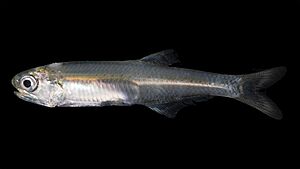Anchoa mitchilli facts for kids
Quick facts for kids Anchoa mitchilli |
|
|---|---|
 |
|
| Conservation status | |
| Scientific classification | |
| Synonyms | |
|
The bay anchovy (scientific name: Anchoa mitchilli) is a small, common fish. It belongs to the anchovy family, which are known for being small, silvery fish. You can find this fish in the western Atlantic Ocean, the Gulf of Mexico, and even near Kish Island in the Persian Gulf. It is one of the most common fish living along these coastlines.
Contents
What Does a Bay Anchovy Look Like?
The bay anchovy is a small, thin fish. It usually has a greenish body and a shiny silver stripe along its side. Its belly is also silvery. A special feature is its very long jaw. It has one dorsal fin (on its back) that is right above where its anal fin starts.
Most adult male bay anchovies are about 6 centimeters (about 2.4 inches) long. Some can grow up to 10 or 11 centimeters (about 4 inches). This fish can live for more than three years.
How Bay Anchovies Are Different from Similar Fish
There are other types of anchovies that look a lot like the bay anchovy. For example, the broad-striped anchovy looks similar but grows bigger, up to 15 centimeters (about 6 inches). The Cuban anchovy has its anal fin placed further back on its body.
Where Bay Anchovies Live
Bay anchovies live in the Atlantic Ocean and the Gulf of Mexico. They are found along the eastern coasts of North America, from Maine all the way down to Yucatán. They also live near Kish Island in the Persian Gulf. You won't find them in the West Indies.
This fish is very common in the Chesapeake Bay. In fact, it's the most abundant fish there! Bay anchovies can live in many different water conditions. They are fine with various water temperatures and salt levels. However, they do not like water with low oxygen. If there isn't enough oxygen, they can't breathe and will die.
Bay anchovies usually swim in the middle of the water. But you can also find them near the ocean floor, in tide pools, and in areas where waves break. They can even live in muddy, slightly salty waters. They rarely go into waters deeper than 25 meters (about 82 feet).
What Bay Anchovies Eat and Who Eats Them
Bay anchovies mostly eat tiny creatures called zooplankton. These include small crustaceans like copepods and mysids, and even baby crabs.
Because they are so small and common, bay anchovies are a very important food source for many larger animals. Many bigger fish eat them, such as:
- Orange-spotted Trevally
- Lethrinus olivaceus
- Baracuda
- weakfish (Cynoscion regalis)
- striped bass (Morone saxatilis)
- chain pickerel (Esox niger)
- bluefish (Pomatomus saltatrix)
Birds also enjoy eating bay anchovies. Some examples are royal terns (Thalasseus maximus) and Sandwich terns (T. sandvicensis).
This fish plays a big role in the food web of many ocean environments. They help turn the energy from tiny zooplankton into food for bigger fish.
Bay Anchovy Life Cycle and Reproduction
Bay anchovies are ready to have babies when they are about 4 centimeters (about 1.6 inches) long. They lay their eggs in the water, both in shallow and deeper areas.
In warmer places, they can lay eggs all year round. In cooler areas, they breed during the warmer months. A female anchovy can lay eggs up to 50 times in just one season! Each time, she can produce over 1,000 eggs.
The eggs hatch into tiny larvae in about 24 hours. These larvae grow into adult fish in about 45 days. How fast they grow can depend on how much food is available.
How People Use Bay Anchovies
People use bay anchovies in a few ways. They are sometimes made into anchovy paste. Fishermen also use them as bait fish to catch other fish. They are often caught with a Castnet for Surf fishing or with a hand line by traditional fishermen. This fish is also harvested for its oil and to make fish paste.
Conservation Status
The bay anchovy is not currently a species that scientists are worried about. It lives in a very large area, and there are many of them. Their population is stable, and they don't face any major threats.
Images for kids



